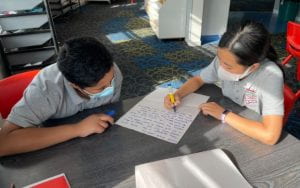LI: To write an imaginative paragraph that makes sense.


This week LS2 learned a game called quick write. My partner and I did three quick write challenges, and the paragraphs written needed to make sense by using the words provided. The main idea of doing this activity was using words that actually dont go together like tree and chair.
For the first challenge, we did 2 words for 2 minutes, and then we did 3 words for 3 minutes individually. Our goal was to try to beat our last quick write, and this meant that we could write any type of text story, but it had to come together and understand what the text means.
Lastly we did a super paired challenge. It was 7 words and 7 minutes. Each 7 groups had to pick one of the 4 nouns, 1 adjective, 1 adverb, and 1 transitional word, and we picked a word stand as an adverb, so this meant it was 7 words and 7 minutes, our total words we wrote were 108.
We enjoyed doing this activity because we were able to learn what quick write is and how we could do it.



